









Sodexo’s security leader says hybrid tech recreates what’s possible.
Carlow Rugby Club has a pure love of the game.
Aboretum plants a successful future based on Rachel Doyle’s vision.
Demand for PVM drives global expansion and ADES growth.
TELLUS: A
Texas-based equipment provider ensures safety and reduces loss
A key Netwatch leader describes her road to the top.

Netwatch is redefining security by delivering proactive solutions that go beyond traditional monitoring. Our technology is purpose-built to empower organizations with real-time intelligence, enabling them to stay ahead of potential threats We’ve invested in rigorous operator training and cutting-edge AI-driven video monitoring to ensure rapid, informed responses We don’t follow the status quo we set the standard

By now, the transformative potential of AI-enabled security technology has become clear to anyone who follows industry trends. Intelligent, AI-powered remote video and alarm monitoring that streamlines the flow of incidents across thousands of locations to improve accuracy and increase response time is one of the first examples of AI being used to dramatically increase the efficacy of security operations, but the possibilities don’t end there.
In the near future, organizations will increasingly turn to AI-powered offerings to improve critical functions like video surveillance, employee safety, and access control, enabling a more proactive and efficient approach that augments and complements the work of security experts. As the prevalence of these services grows, however, we face key questions on how best to integrate new solutions into existing technology stacks without creating disorder and disruptions in workflows that defeat the purpose of adopting innovative products in the first place.
When an organization's technology stack expands, each addition becomes a new piece of a high-tech puzzle that security and IT teams must solve. While this phenomenon presents a potential threat to productivity, it also offers an opportunity for security service providers to lighten the load using AI-enabled SaaS solutions that unify and consolidate key functions across one platform
By adopting an as-a-service approach to tech-enabled security solutions, providers can consolidate offerings into one integrated package, and ensure the smooth integration of AI-powered innovations across existing workflows Implementing the right SAAS platform alleviates the pressure to constantly update and maintain each part of the tech portfolio, allowing users to focus on what matters most: their business.
It’s worth noting that the real value of AI-powered technologies doesn’t come in replacing the presence of human operators in security it lies in augmenting their capabilities across a broad spectrum of activities. AI enhances the efficiency and accuracy of the security solutions teams use daily by automating routine tasks and better organizing and prioritizing the flow of critical information, allowing operators to focus their attention and efforts on mission-critical activities.
As the prevalence of AI-enabled security solutions increases, it’s important for organizations to invest in creating technology-based services that support seamless operations, simplify management, and deliver value for customers. Implemented properly, AI isn't just a tool for automating tasks we don't want to do it's the foundation for the next generation of security technology.
Kurt Takahashi


By Simon Pears, Global Security Director, Sodexo
When we think of security, traditional measures like physical guards and security officers often come to mind These professionals have served as the frontline protectors of assets and environments for more than a century, providing a reliable career path within the security industry However, human error is inevitable, and even the best-trained security personnel can make mistakes, leading to potential breaches
In recent years, the rapid advancement of technology in the security sector has presented an enticing alternative to human guards Replacing physical security with technological solutions might seem like a straightforward fix However, as the world has discovered, technology is not infallible either When systems fail, they can introduce significant security risks, revealing the limitations of relying solely on machines At present, neither human nor technological solutions can be trusted to provide 100% reliability on their own
As the world evolves, so too do the threats we face The persistent global threat of terrorism, increasing natural disasters, and environmental challenges are putting unprecedented strain and challenges on security teams and emergency services. Meanwhile, as our technological infrastructure becomes more complex and integrated, the potential for new risks grows. Risk mitigation will become more critical as we navigate these ever-shifting landscapes, acknowledging that some risks cannot be entirely eliminated.
Furthermore, geopolitical instability and social unrest are adding new layers of complexity to security challenges These developments necessitate a more dynamic approach to security planning, where adaptability and rapid response are key In addition, the rise of remote work and distributed teams, accelerated by the COVID-19 pandemic, has expanded the perimeter of security concerns Protecting sensitive information and assets in this new landscape requires innovative strategies that account for both physical and cyber threats


The solution to future security challenges lies in a hybrid approach one that balances the strengths of both human expertise and technological tools. Together, they form a more resilient and comprehensive security strategy.
Artificial intelligence is playing an increasingly significant role in security, from intelligence gathering and trend analysis to drafting processes, procedures, and standard operating procedures. However, despite AI's growing capabilities, these systems still require the oversight of seasoned security professionals who bring local knowledge and practical experience to the table.
AI also enhances the effectiveness of video surveillance and monitoring systems, where specific behaviors and actions can trigger alerts However, the accuracy of these alerts depends on the quality of the data the AI is trained on To ensure long-term effectiveness, future solutions must be designed to access and incorporate the most current and relevant information
Moreover, AI-driven predictive analytics are now being employed to anticipate potential security incidents before they occur. By analyzing historical data and identifying patterns, AI can forecast where and when security breaches are likely to happen, allowing for pre-emptive measures. This shift towards predictive security represents a significant evolution from the reactive models of the past.
The rise of cloud technology has transformed data and image storage, offering organizations a viable alternative to on-site equipment like DVRs and NVRs. Thanks to improvements in bandwidth and data transfer speeds, cloud storage has become increasingly practical.
Remote monitoring capabilities have also advanced, bolstered by better and more stable Internet connections AI now enables many environments to be monitored remotely, with remote teams ready to notify on-site security personnel when local action is required, such as coordinating with emergency services
Traditionally, security has been reactive, responding to incidents after they occur However, technology is shifting the paradigm towards a more proactive approach, where vast amounts of data are analyzed to predict and prevent threats with a high degree of accuracy
Biometric technology, once met with resistance due to privacy concerns, is gradually gaining acceptance, largely because of its widespread use in personal devices, banking systems, and smartphones As users become more comfortable with biometrics, the adoption of facial recognition technology is likely to expand This will not only enhance user experience and security controls but also reduce risks by efficiently managing access to facilities.
Additionally, multimodal biometrics which combine two or more biometric indicators, such as fingerprint, iris scan, and facial recognition are being increasingly adopted to improve accuracy and security. This technology offers a higher level of assurance by reducing the likelihood of false positives or negatives, making it harder for unauthorized individuals to bypass security systems.
A hybrid security model offers several key benefits: Continuous Monitoring: A consistently vigilant system that monitors threats in real-time Informed Security Teams: A leaner, more knowledgeable security force that is better trained, highly engaged, and motivated
Layered Protection: Multiple layers of security, combining human expertise with advanced surveillance technologies, result in greater protection, awareness, and risk reduction
Cyber threats will continue to be a concern, making cybersecurity awareness paramount As we move towards an era of "Zero Trust," where every system and device is treated as a potential threat, the interconnectivity of our systems becomes both a strength and a vulnerability Recent incidents have demonstrated how a single rogue software update or attack can disrupt society
To address this, the convergence between traditional physical security teams and corporate IT and technology functions must deepen. Every camera, door reader, and sensor connected to a network could potentially cause significant disruption if not properly validated. This is why adopting a "Zero Trust" policy is critical. Thorough checks, validation, and backup strategies must be in place before any device is connected. Regular security updates and maintenance are also essential to mitigate risks effectively.
However, this shift also presents valuable opportunities for collaboration between different security disciplines By working together, sharing expertise, and cross-pollinating ideas, security teams can enhance the organization's

The line between cybersecurity and physical security is blurring, with the increasing interdependence of these domains creating new challenges and opportunities Modern security strategies must address both physical and digital threats in a cohesive manner For instance, the integration of cybersecurity measures into physical security systems is becoming standard practice
Converged security platforms are emerging, which integrate physical security controls, such as access management and surveillance, with cybersecurity measures like network monitoring and threat detection. This convergence allows for a more holistic approach to securing assets, where data from various sources is correlated to provide a unified view of potential threats.
Furthermore, the rise of smart buildings and the Internet of Things (IoT) introduces additional layers of complexity.
Smart sensors, connected devices, and automated systems are becoming common in modern infrastructures, providing real-time data that enhances security but also increasing the potential attack surface for cyber threats As a result, security teams must ensure that these IoT devices are properly secured and monitored to prevent them from becoming entry points for malicious actors
Looking ahead, the future of physical security will be defined by the integration of cutting-edge technologies with human oversight As AI, biometrics, and cloud technologies continue to evolve, their roles in security

THESOLUTIONTOFUTURESECURITYCHALLENGESLIESINA HYBRIDAPPROACH ONETHATBALANCESTHESTRENGTHS OFBOTHHUMANEXPERTISEANDTECHNOLOGICALTOOLSTO FORMAMORERESILIENTANDCOMPREHENSIVESTRATEGY
strategies will expand, enabling more proactive and efficient threat detection and response
However, technology alone will not be sufficient The human element remains crucial, providing the context, judgment, and adaptability that machines lack Security professionals will need to continuously upskill, staying informed about the latest technological advancements and how they can be leveraged to enhance security
Ultimately, the most effective security strategies will be those that seamlessly integrate human expertise with technological innovation, creating a robust and adaptive system capable of meeting the challenges of an increasingly complex world.


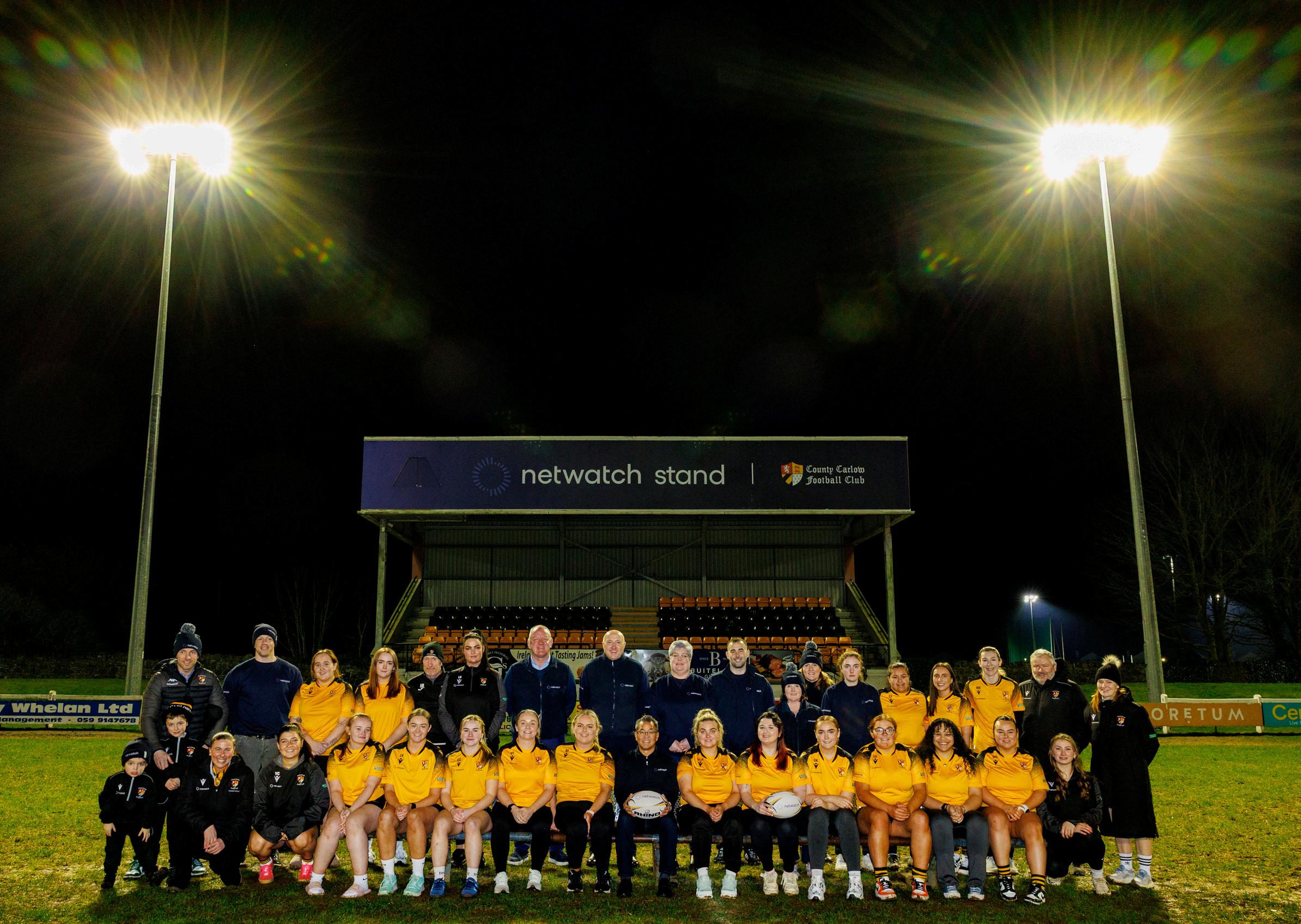
Carlow Rugby Club Strengthens Community Ties
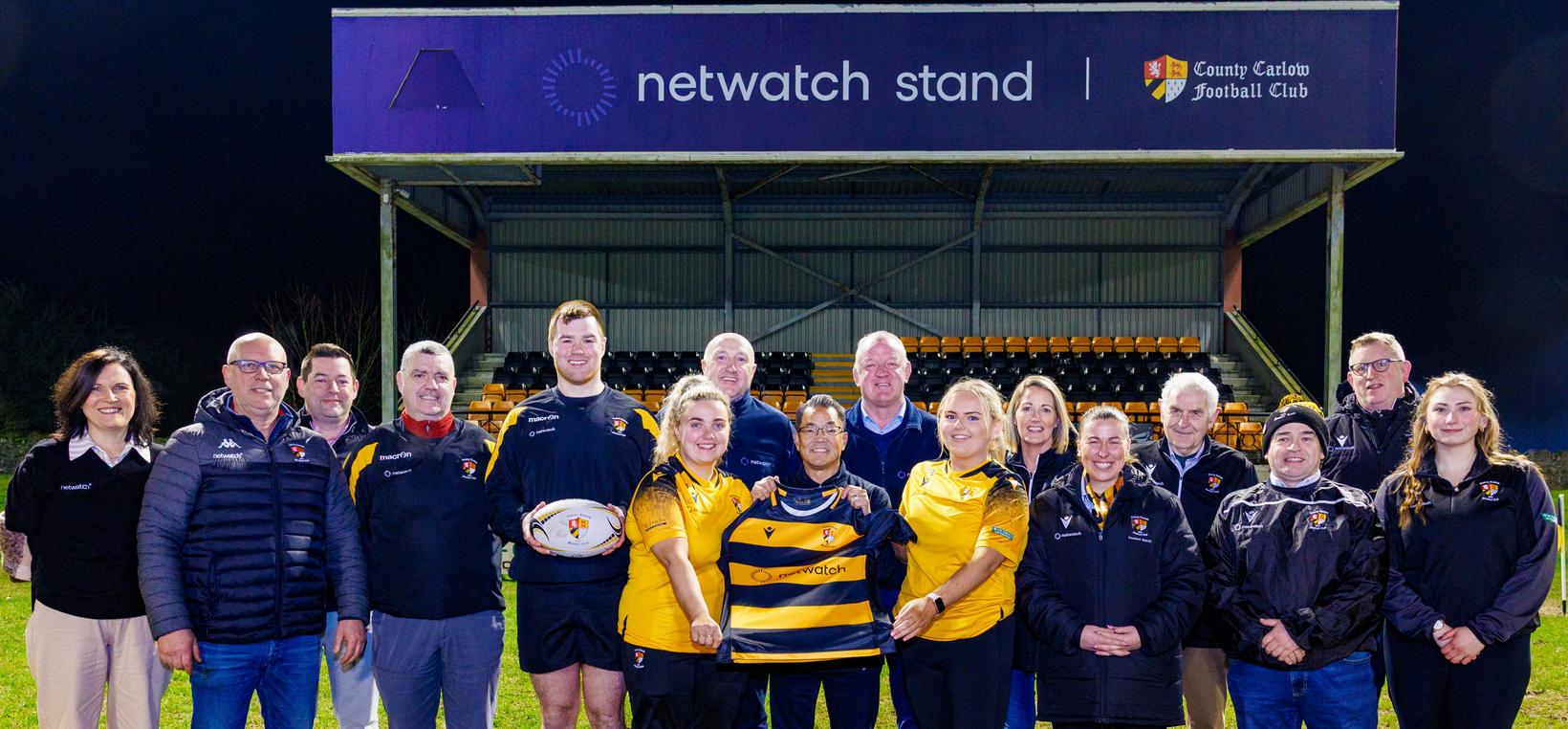
For more than two decades, Netwatch has been deeply rooted in the Carlow community not just as a business but as a dedicated supporter of local initiatives that bring people together. One of its most valued partnerships is with Carlow Rugby Club, a relationship that extends far beyond financial sponsorship that plays a meaningful role in strengthening the community.
Founded in October 1873, Carlow Rugby Club is one of Ireland’s oldest rugby institutions. Generations of players it is Ireland’s second oldest rugby club have donned the black and amber jerseys, carrying forward the club’s history with an enormous sense of pride. The club supports rugby for all ages and focuses on three key pillars: community, teamwork, and passion
"Netwatch’s commitment to Carlow Rugby Club and the wider community has been a game changer for the club" said Muireann Brennan, President, Carlow Rugby Club "Their partnership reinforces our shared commitment to the future of rugby in the locality Their continued support will help us build a strong and sustainable future, allowing us to develop local talent, enhance our facilities, and create lasting opportunities for players for years and years to come."
Founded in 2003, Netwatch has grown into a global leader in proactive video monitoring, protecting more than 300,000 sites worldwide and employing over 400 people. Yet despite its international reach, the company has never lost sight of its roots. Supporting the Carlow community remains a top priority.
Carlow Rugby Club is more than a place to play rugby it’s a space where families, friends, and players come together That's what makes its partnership with Netwatch such a great fit Both share a strong commitment to safety, teamwork, and family, values that align with Netwatch's mission to create a more secure world page 20
Netwatch's contributions have ensured that the club remains a space where future generations can develop their skills, forge friendships, and participate in this popular sport played at the club, province, and national levels The initiative also aligns with Netwatch's mission to ensure safe and secure communities worldwide and allows it to stay closely aligned with where it all started
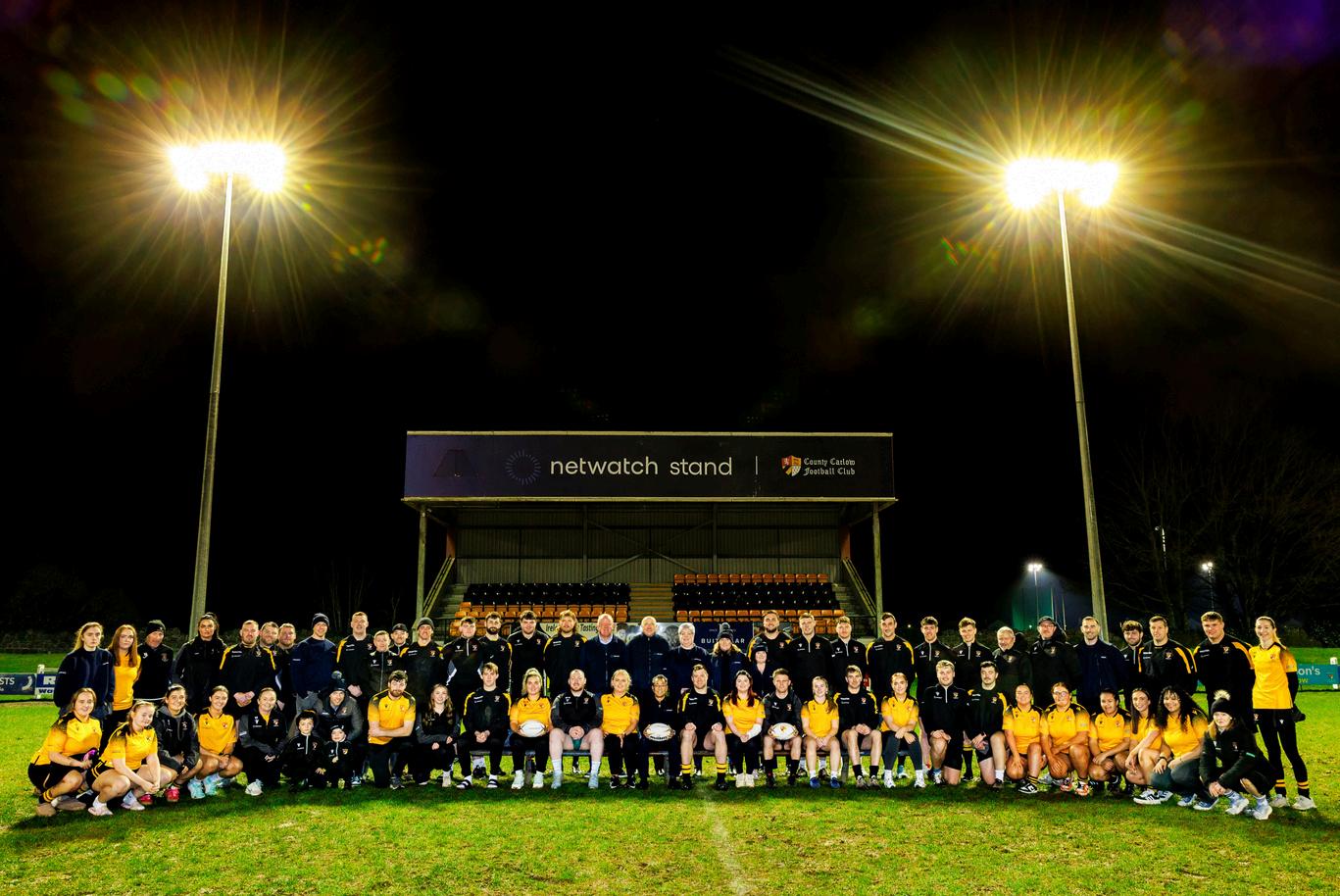
"We are especially proud to support Carlow Rugby Club as part of our commitment to the community," said Kurt Takahashi, CEO, Netwatch "Netwatch was founded In Carlow, and giving back is a core part of our identity
Over the years, we've worked with and supported many local organizations, including Carlow Rugby Club These relationships are integral to who we are, and we remain committed to supporting them as we expand and grow "
Netwatch's partnership with Carlow Rugby Club supports and empowers the community and demonstrates the impact of working together. As Netwatch expands, it remains committed to Carlow, supporting the area that helped shape its success.
For more information on the Carlow County Rugby Club, visit https://carlowrugby.ie.
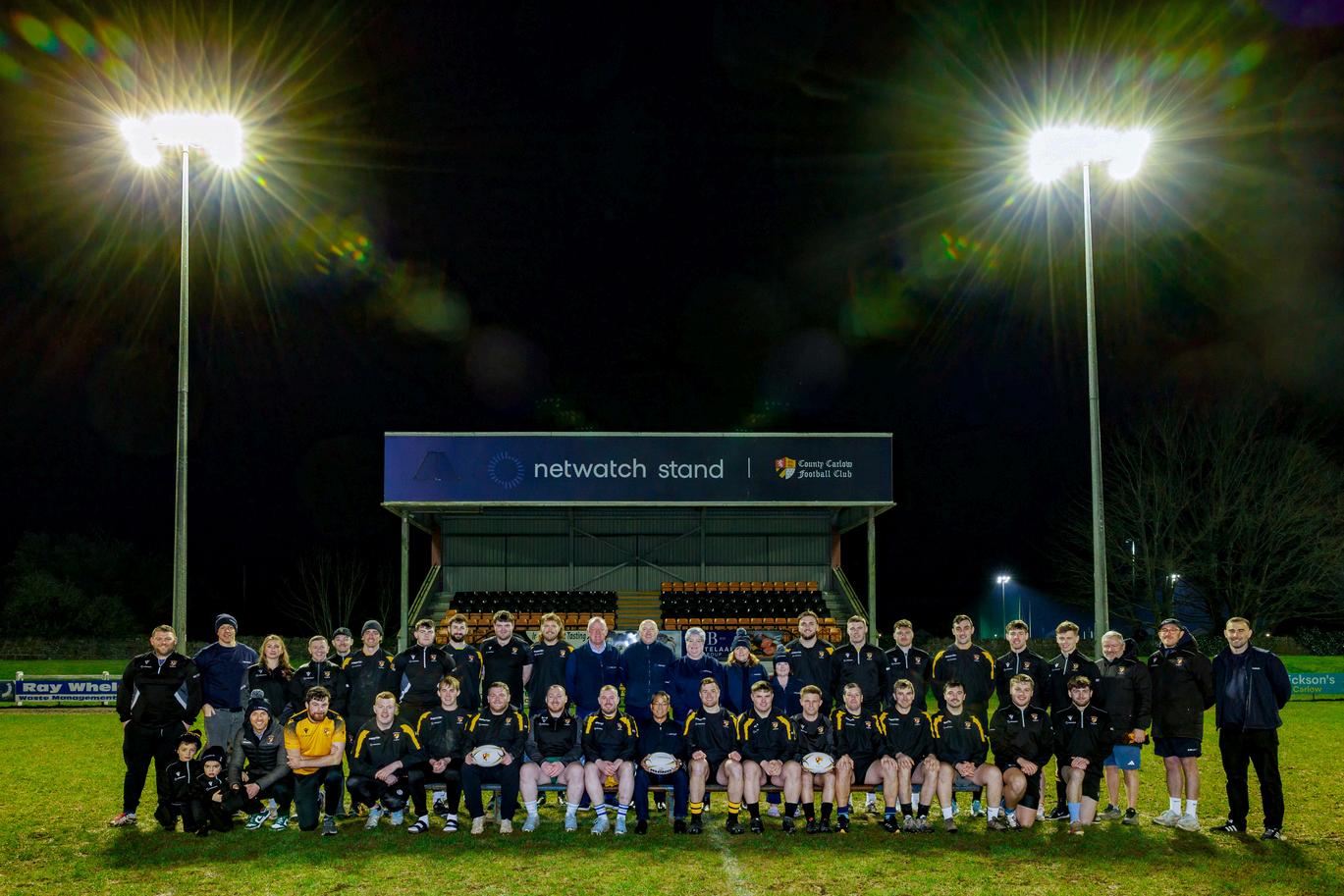

By Mark Glynn
In an era where digital integration is woven into nearly every facet of security operations, the need for a robust and adaptable cybersecurity framework has never been more critical Security companies are no longer evaluated solely on their ability to protect physical assets but on their capacity to be part of the safeguards for complex digital environments that span global operations This underscores the vital importance of cybersecurity awareness, not just for the companies themselves, but for their customers and partners who rely on these protections
Cybersecurity, once considered a niche concern, has evolved into a central pillar of modern enterprise operations A decade ago, physical security end users might have balked at the idea of cyber considerations playing a role in their procurement decisions Today, those same organizations demand rigorous cybersecurity protocols before engaging with a provider The risks have shifted threats to uptime, vulnerabilities to networks, and data breaches are now primary concerns for enterprises operating at scale.
For security companies, this evolution necessitates a mindset shift. Cyber awareness has become the equivalent of the "safety-first" culture seen in industrial settings only instead of tracking injury-free days, organizations focus on maintaining strong cyber hygiene over the long term. From rigorous internal training programs to meticulous cybersecurity questionnaires, companies must demonstrate compliance and proactive leadership in protecting their own systems and those of their clients.

The journey toward cyber resilience often begins with humble origins In the early days, a single IT person may have been responsible for on-premise systems, with basic cybersecurity tools in place However, as organizations grew and cyber risks expanded, so too must a corporate commitment to security from door to network The appointment of dedicated roles, such as a group cybersecurity officer, marked the turning point where cybersecurity shifted from a functional necessity to a strategic priority
For example, as companies expand from local operations to global enterprises, they face the dual challenge of meeting local needs while preparing for the heightened expectations of enterprise clients The rigor required by these clients, often defined by detailed IT and cybersecurity assessments, forces organizations to mature their capabilities. This builds trust and establishes the foundation for long-term partnerships.
Enterprise clients, especially those with global operations, approach vendor relationships with heightened scrutiny. IT and cybersecurity personnel are central to initial discussions, often setting the entire agenda for whether a

partnership can proceed Today, without being able to demonstrate the existence of robust cybersecurity measures, security solutions vendors face insurmountable barriers to entry

These expectations are not arbitrary they stem from the very real risks enterprises face when integrating third-party vendors into their networks. A single cyberattack on a security provider’s video surveillance cameras, for example, could cascade into disruptions for the client’s infrastructure, leading to downtime, data breaches, or worse. The stakes are simply too high for enterprises to entertain vendors who cannot meet their cybersecurity requirements.
Far from being a burden, a strong cybersecurity program is a critical driver of growth in today’s market. It opens doors to new opportunities, particularly in the enterprise space, where the ability to pass rigorous cybersecurity evaluations is often the deciding factor in closing deals Companies that invest in cybersecurity position themselves as capable providers as well as trusted partners who understand and prioritize their clients’ operational security
Moreover, as enterprise customers increasingly demand secure data transmission and infrastructure, physical security providers must collaborate closely with their internal IT teams to ensure these requirements are met throughout the product roadmap This collaboration, from securing certificates to building secure architectures, demonstrates a commitment to aligning with enterprise standards and ensures seamless integration into the customer’s environment.
As cybersecurity continues to dominate the agenda for businesses worldwide, it is imperative to maintain a forward-thinking approach. This involves addressing immediate threats while building a culture of continuous improvement. From internal training and strong hygiene practices to collaboration with IT and cybersecurity leaders, the goal is clear: to create a resilient, secure foundation that protects both the organization and its customers.
By embracing this mindset, technology providers can meet evolving market demands, foster trust with enterprise clients, and drive sustained growth in an increasingly interconnected world Let’s face it cybersecurity is the cornerstone of success in today’s security landscape
Mark Glynn has over 18 years of experience in information technology and management roles Mark is currently the Chief Information Officer at Netwatch Group, a world leader in proactive video monitoring. In this role, he oversees the company's operations and ensures the effective use of IT systems. Prior to this, Mark served as the Group IT Director for Netwatch Group.
Rachel Doyle, founder of Arboretum garden and lifestyle centres, talks about her 45-year career in business including setting up shop as a woman in the 1970s.

By Rachel Doyle Founder & Executive Chair Arboretum Garden Centres
I went to college at the age of 22 to study commercial horticulture. It was the 1970s, a time when it was not the norm for a woman from a rural working-class background to participate in third-level education never mind as a mature student. My father was a wonderful gardener and he had encouraged my interest in plants Having worked in an office and as a national school teacher, I felt for the first time that I had a purpose; I was learning about something I had loved since I was a child It was a dream come true for me Another dream soon took its place: I was determined to open a garden centre
I knew from the beginning that my new enterprise was to be called Arboretum This name is usually given to collections of trees in botanical gardens but I thought it would be appropriate for my new business I initially ran it from a half-acre plot at my home, a bungalow close to the village of Leighlinbridge, County Carlow, opening from 3:30 p.m. and at weekends because I was teaching. My new husband, Frank, helped me in the business when he could, though he had a full-time job in sales.
In those days, it was rare for a woman to run a business. More than once I was greeted with “Is himself around?” when a customer arrived at the nursery. My reply was “Himself would be no good to you, I’m the horticulturist”. Banks did not take a woman seriously, so when I was looking for my first loan I had to take Frank with me It was such nonsense
In 1982, we decided to rent a large yard in the larger town of Carlow and ran the garden centre there The business was going well and after a few years of paying high rent, we took the significant decision to buy a site in the town Embarking on a new venture with a new site and new building, I saw an opportunity: I ensured our shop would be large enough to house a café This turned out to be a very good decision as our business is today synonymous with great food I believe we were the first garden centre in Ireland with an in-house café.


At the turn of the millennium, we sold that site and developed Arboretum Home and Garden Heaven on a 10-acre site in Leighlinbridge, a stone’s throw from the bungalow where it had all started. Fast forward to today and we have three garden centres: in 2015, we acquired the former National Garden Exhibition Centre in County Wicklow, and two years ago we opened a garden centre in Dublin city centre aimed at urban gardeners, Arboretum Urban Green on Parnell Street.
As you can imagine, security on our sites has always been a preoccupation Between cash and high-value stock, we were regularly targeted Living next door to the Leighlinbridge site left me feeling particularly vulnerable Then I discovered Netwatch We were one of their first customers I knew and admired David Walsh and Niall Kelly as our businesses were both based in County Carlow and I had succeeded David as president of Carlow Chamber of Commerce
As the new president of the Chamber of Commerce, during the launch of Netwatch’s control centre, I was asked to say a few words. I said with all honesty that I would let the automatic gates, the dishwasher, and the kitchen table go before relinquishing Netwatch. That is how important it is to our peace of mind. I am thrilled with their success but not a bit surprised. The concept and technology were ground-breaking.
Arboretum has been a family affair since the beginning. Frank joined the business full time before we moved it to Carlow and my sons Fergal and Barry came on board early in their working lives. Frank retired in 2013, and we felt it was the right time to do some succession planning. Fergal and Barry now run Arboretum and I remain on the board as the Executive Chair. It is working out better than I could ever have imagined and I’m so proud of how the boys are steering Arboretum. Passing on the business is one of the proudest achievements of my business life
Looking to the future, we are committed to sustainability We owe it to the planet and also to our staff, suppliers and the communities we are embedded in to ensure we can bring the joy of gardening to future generations Under Fergal and Barry’s stewardship, we used the redevelopment of the County Wicklow store last year to green our operations with rainwater harvesting, solar electricity and much more We have replicated many of the schemes at our other stores Reducing our carbon footprint further will be a focus going forward.
The business world is always changing; it’s one of the reasons I love it so much. I believe we must embrace that change and remain agile. We must stand our ground when we must but turn the sod on new ground when we can.
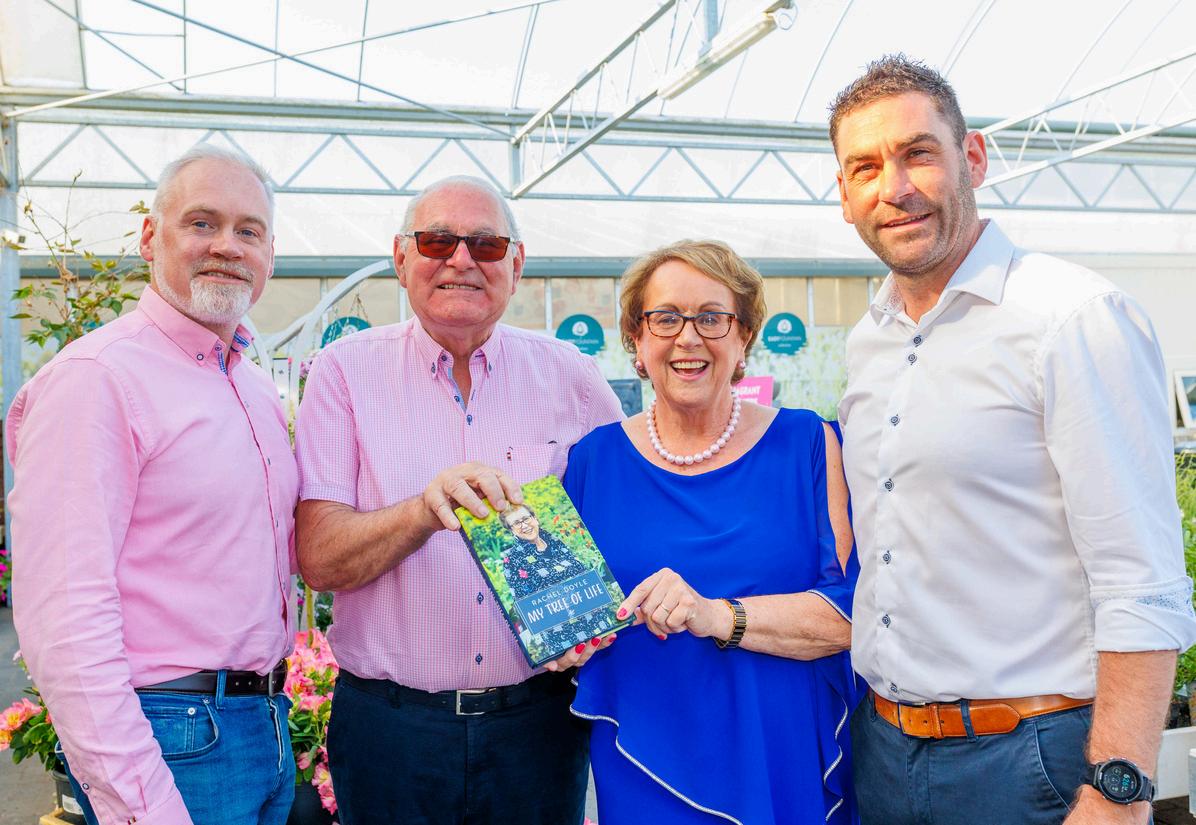

A Bold Partnership Between Netwatch and ADES Reshapes the Global Reach of AI-enabled Video Monitoring
W A T E R S
no surprise that the video surveillance market is growing. The global demand for video monitoring is accelerating, driven by escalating security concerns across industries.
This growth is propelled by advancements in AIpowered analytics and cloud-based solutions, enabling more efficient and intelligent surveillance. The global Video Surveillance-as-a-Service (VSaaS) market, valued at $3.69 billion in 2022, is projected to grow at a compound annual growth rate (CAGR) of 17.8% from 2023 to 2030.
Netwatch’s international expansion is a direct response to this rising demand. Now operating in 14 countries and continuing to scale, the company is well-positioned for substantial growth opportunities worldwide
A cornerstone of this strategy is its partnership with ADES, the exclusive distributor of Netwatch services in New Zealand This collaboration enhances Netwatch’s regional footprint, ensuring businesses across the country gain access to advanced remote video monitoring solutions
Since its founding in 2016, ADES has become a trusted electrical, data, and security provider across Auckland, New Zealand. Known for its commitment to quality and innovation, the company has built a strong business by delivering advanced solutions and services to its customer base. And now, ADES is taking security to greater heights. By delivering Netwatch’s proactive video monitoring solutions to this market, it is redefining how businesses safeguard their assets.
Growing up in Ireland, Nigel Byrne, the current business development director at ADES, always felt a profound sense of safety with Netwatch’s presence in his community If he saw Netwatch monitoring, he knew he was in well-equipped hands if his safety was to be threatened This assurance was invaluable, especially as he started his own family Now living in New Zealand, Nigel sees the increasing crime rates and wants to provide the same level of security for his loved ones and community here

Joining forces with his business partner Pete with whom he has successfully run ADES Electrical, an electrical company,
for more than eight years, Nigel is excited to bring Netwatch's unique solutions to the region Witnessing the success of Netwatch across Ireland, the United Kingdom, and the United States, their experience at ADES, known for high-quality installs and strong business connections, perfectly complements Netwatch’s proactive approach to security
Security technology has advanced beyond merely recording incidents today’s solutions focus on preventing threats before they occur Netwatch’s proactive video monitoring, supported by trained operators, enhances remote surveillance by detecting and responding to live security threats in real-time.
When a threat arises, monitoring center operators can take immediate action. They use live audio warnings to alert intruders that they are being watched, effectively deterring criminal activity before it escalates. By combining AI-powered detection with human expertise, the system strengthens security and reduces disruptions.
This intelligent approach minimizes false alarms, accelerates response times, and allows businesses to focus on real security risks. Additionally, AI-driven analysis enhances human oversight by processing large volumes of data to
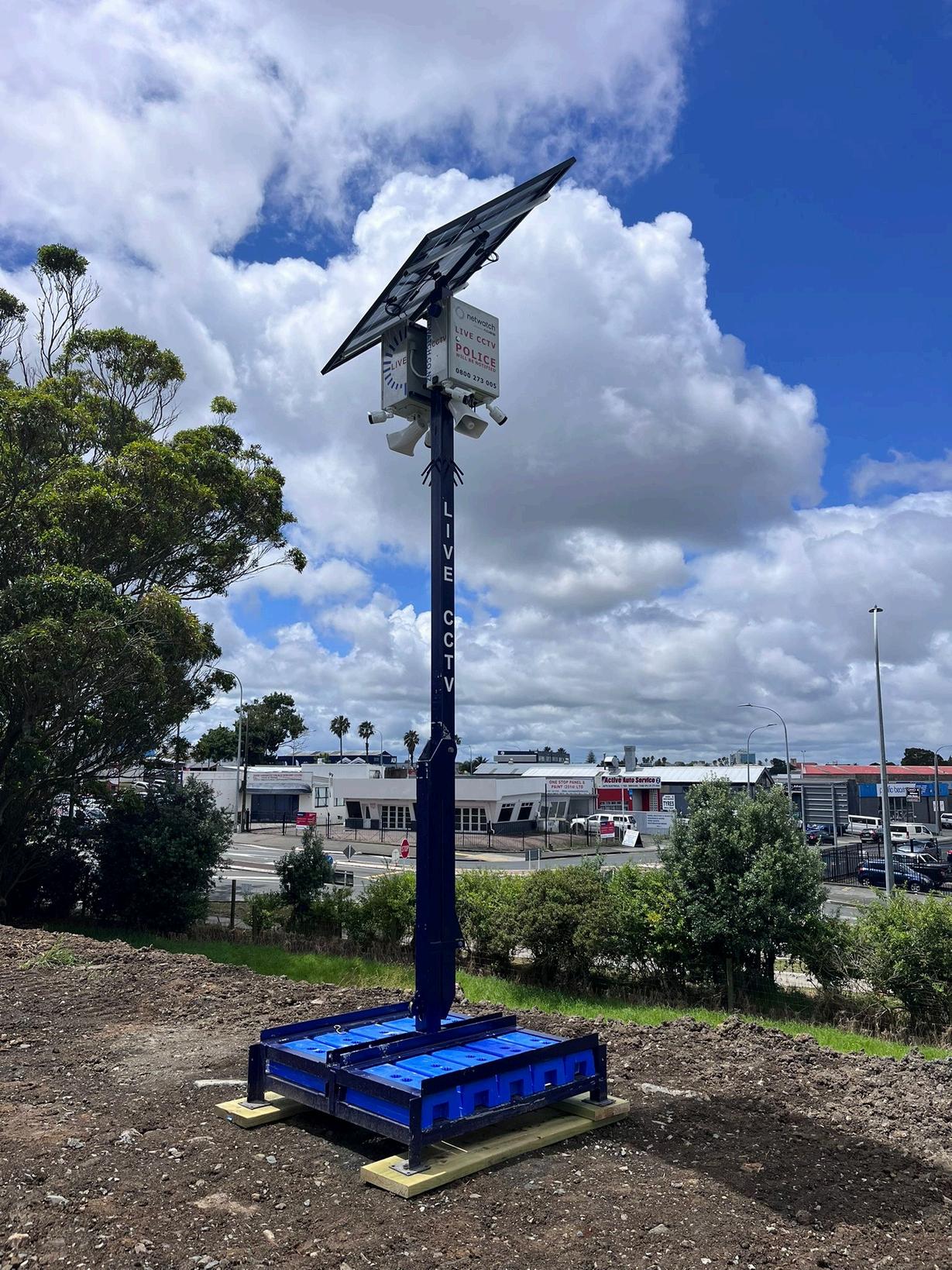
“After 40 years in policing and security, I’ve seen my fair share of intrusions,” said Gavin Clark, Security Consultant “Today, I manage 120 video streams across three large construction sites, and we ’ ve dealt with multiple break-ins over the years Since implementing ADES Netwatch Proactive Video Monitoring with live intrevention, it’s been a game changer. Intruders now know they’re being watched in real-time, forcing them to decide continue or leave. Nine times out of ten, they leave. Simply put, it works.”
Bringing this system to New Zealand means local businesses and sites now have access to tech that’s ahead of the curve, ensuring smarter, more proactive protection
“Our partnership with Netwatch allows us to deliver intelligent security solutions that make a difference,” Nigel said “We have built a business around this approach because we see its impact every day Helping businesses protect their assets and ensuring the safety of people is at the heart of what we do ”
ADES and Netwatch are working together to deliver PVM to new areas, helping transform the investment in video surveillance.
“Our global presence continues to grow, and we are proud to have ADES as part of our network of resellers,” said Netwatch CEO Kurt Takahashi “We are excited about the future rollout of our solutions in this market ”
ADES is proud to lead the way, offering a fully integrated service that keeps businesses running efficiently and securely
This is more than just security It’s the future of business protection


Texas- based Equipment Provider Turns to Modern Technology to Strengthen Security and Crime Prevention


For businesses with high-value equipment and open environments, theft and vandalism can pose significant risks Tellus Equipment Inc , a leading John Deere equipment dealer in Texas, has seen these challenges firsthand One year, it experienced losses of $500,000 Seeking a more effective approach to limiting loss and crime, Tellus sought to invest in a more modern technology solution to augment its existing strategies and personnel
Tellus operates multiple locations across the great state of Texas and its locations are storing grounds for an array of valuable agricultural and construction equipment. Whether it’s the rolling hill country, fertile Gulf Plains, or Rio Grande Valley, Tellus Equipment knows the lay of the land and is proud to support outdoor work with its wide variety of John Deere equipment.
Having always been security-focused, the company had invested in a remote video monitoring system that recorded activity but lacked true real-time intervention Security breaches would trigger prerecorded audio messages that intruders often ignored, just as many of us ignore car alarms, said Terry Brooks, the organization’s Security
Manager But despite having video surveillance footage to reference for investigations, Tellus struggled to deter criminal activity leading to recurring theft and increasing insurance costs
The company gave Brooks a clear directive: find a solution that prevents theft, rather than merely recording it
After a detailed evaluation of remote monitoring providers and parting ways with its existing vendor, Brooks found Netwatch and was interested in exploring how its ability to provide live audio intervention could benefit its business. Unlike conventional RVM systems, Netwatch utilizes live operators who actively monitor and engage with potential intruders through real-time, customized voice-downs.
“Having a live person issue a direct warning to an intruder makes a tremendous difference,” Brooks said “Instead of a generic recording, Netwatch specialists deliver real-time warnings, which completely shifts the security dynamic from reactive to proactive This is what we were looking for ”


Within a year of deploying Netwatch, Tellus saw a staggering reduction in losses, dropping from half a million dollars in previous years to just under $20,000. In addition to reducing these losses, Netwatch helped prevent more than 10 attempted thefts with its proactive video monitoring system.
One particularly incident highlighted the effectiveness of the technology When intruders attempted to steal equipment worth more than $110,000, Netwatch specialists engaged them in real time, calling out specific descriptors of what the individuals were wearing This level of detail and live engagement from Netwatch operators prompted them to flee the scene As a result, Tellus was able to recover the stolen equipment before any losses were realized
“The deterrent effect has been incredible,” Brooks said “Word spreads fast among criminals When they realize a location has proactive monitoring with live intervention, they move on to easier targets.”

Beyond preventing theft, Netwatch’s mobile capabilities have streamlined the company ’ s security operations. The ability to arm, disarm, and control security systems remotely with the Netwatch App has saved the company significant time and resources. With 26 locations to oversee, remote access has allowed the team to respond to alerts instantly without having to be physically present
“In the past, making changes to system settings required multiple steps and external approvals, often taking days to execute,” he said “With Netwatch, we can make changes on demand, ensuring that our security measures are aligned with our operational needs ”
From a law enforcement perspective, the benefits of Netwatch extend beyond theft prevention Live video feeds and real-time intelligence provided to responding officers enhance situational awareness, improving both response times and officer safety.
“Complacency is a real risk for law enforcement when responding to routine alarms,” Brooks said. “With Netwatch, officers receive real-time updates, including descriptions of intruders and their last known locations. This increases the opportunity of making an arrest and improves officer safety by reducing uncertainty in high-risk situations.”
Tellus’ success story serves as a great example of how proactive security solutions can redefine loss prevention and asset protection By shifting from a reactive model to real-time intervention, the company has reduced losses, deterred criminal activity, and optimized security operations
For businesses in industries where theft and vandalism are constant challenges, solutions like Netwatch offer a powerful, cost-effective alternative to traditional video surveillance platforms The ability to actively engage with intruders in real time represents a fundamental shift in security strategy one that Tellus has embraced.
“We’re no longer just recording crime,” Brooks stated. “We’re preventing it.”

BY SIMON WALSHE
Should a company build, partner, or buy? It may sound simple, but this question shapes innovation, outlines growth, and determines an organization’s staying power in a competitive landscape. With technology evolving rapidly and customer expectations reaching new heights, the stakes are higher than ever.
One wrong step in this decision-making process can lead to wasted resources and lost opportunities. On the other hand, the right approach can drive efficiency, differentiation, and success. Each unique path building in-house, collaborating with external partners, or acquiring existing solutions offers distinct advantages and challenges. The key lies in aligning these choices with organizational strengths, market conditions, and future aspirations.

The build, partner, or buy framework is a solid guide for organizations to align their resources with their strategic objectives:
Build: Developing in-house solutions can offer long-term control and customization This approach is most effective when organizations possess the right expertise, resources, and time to create solutions uniquely suited to their needs
However, it’s important to remember that it demands high internal capability and can divert resources from other priorities
Partner: Collaboration with external experts allows companies to access specialized knowledge or technology without building it This approach is particularly valuable when the solution involves cutting-edge or emerging technologies or complex integrations, such as AI analytics or cybersecurity tools.
Buy: Off-the-shelf solutions provide speed and cost efficiency, enabling rapid deployment. However, these solutions often require customization to meet specific requirements, ensuring they align with organizational goals and provide value beyond their standards.
The key to applying this framework effectively lies in assessing when each option is appropriate, considering factors like internal expertise, budget constraints, and the complexity of the problem.
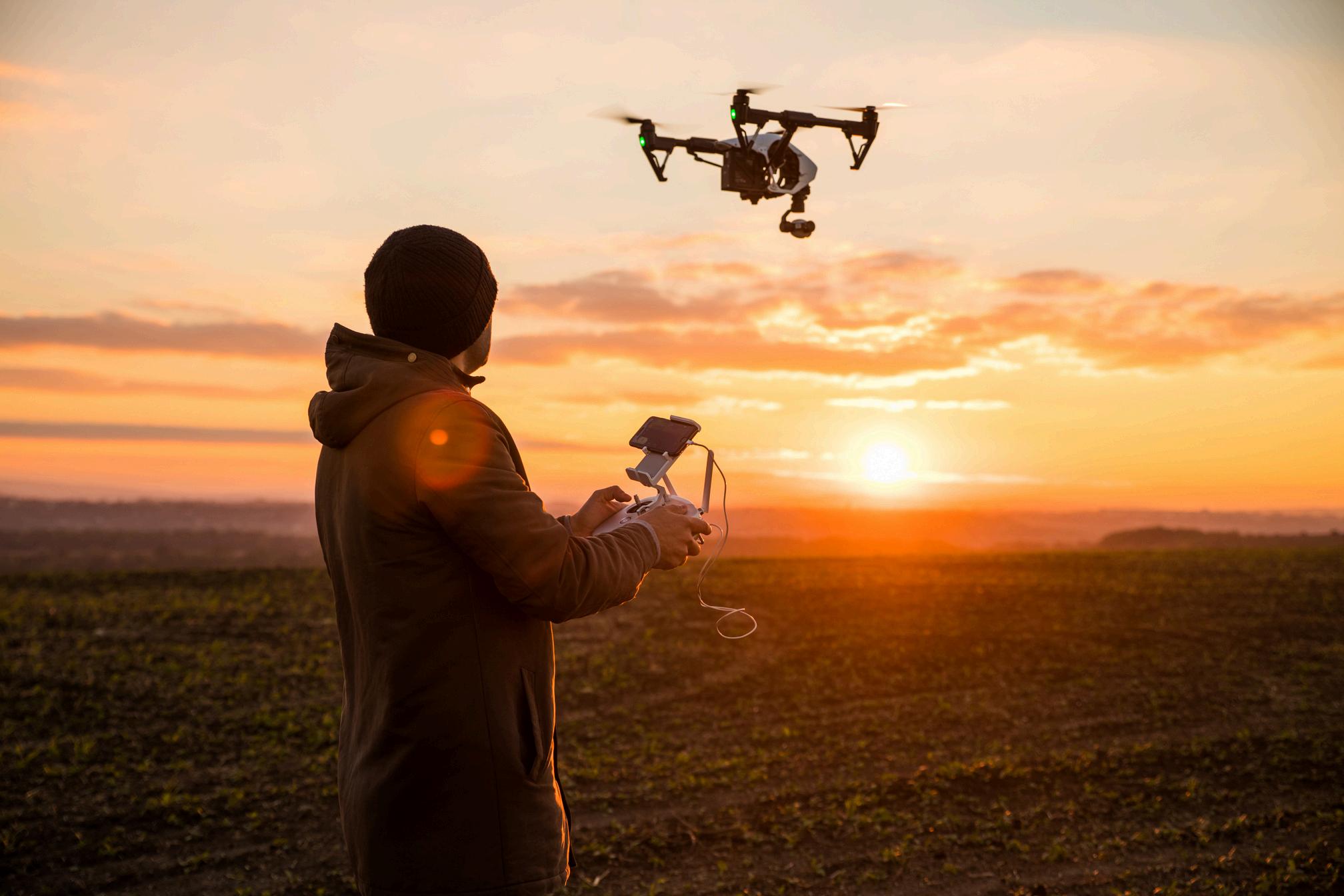
Choosing between building, partnering, or buying is as much about risk management as innovation.Every decision must consider how it will impact the system's reliability, scalability, and security. For example, adopting new technologies like AI requires a thorough assessment of their realworld applicability and alignment with organizational goals.
Businesses must also be wary of over-promising capabilities based simply on industry trends. A measured, strategic approach ensures that technology investments are grounded in practical benefits rather than marketing hype. Always be wary of the buzzwords.
However, it is also important to note that off-theshelf solutions often require modifications to align with specific needs. Customizing these solutions
integrating features, adding security protocols, or streamlining workflows can provide a competitive advantage. This approach ensures the technology fits into existing systems and demonstrates a commitment to innovation and quality.
The build, partner, or buy framework aligns resources, expertise, and market demands. By applying it, organizations can create an ecosystem of technologies and partnerships that deliver tangible value. That’s what we ’ ve done at Netwatch.
Ultimately, the key to success lies in balancing ambition with pragmatism Organizations that prioritize strategic alignment, risk management, and continuous learning are better equipped to navigate the challenges of an evolving industry and deliver innovative solutions that stand the test of time
Simon Walshe is currently a Software Development Manager at Netwatch. He brings experience from previous roles at Kerry Group, Dublin Institute of Technology and Netwatch System.


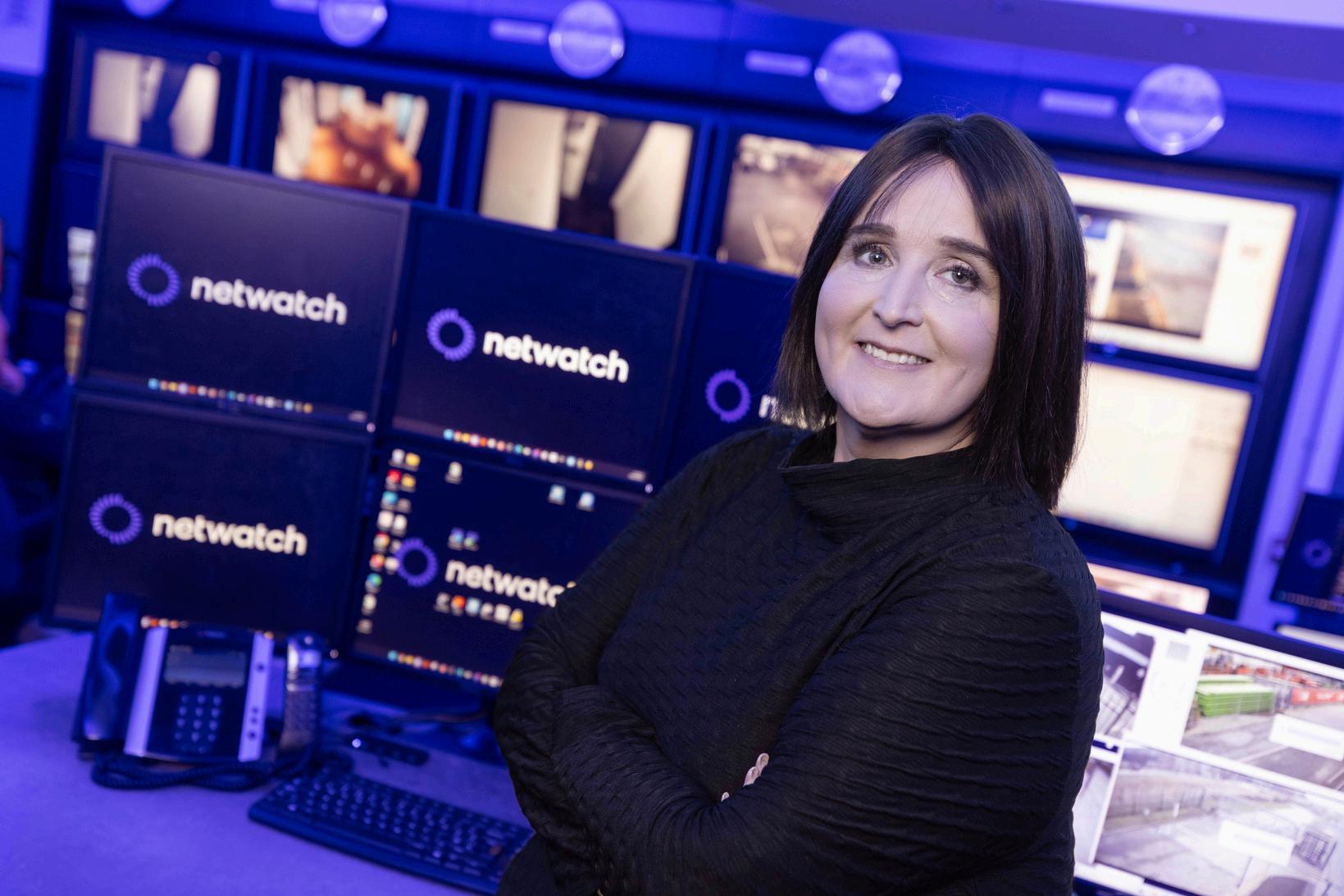
ANN FITZPATRICK NAVIGATES HER WAY FROM INTERVENTION SPECIALIST TO OPERATIONS LEAD WITH A LITTLE HELP FROM NETWATCH, A SUPPORTIVE TEAM, AND A CULTURE FOCUSED ON SUCCESS.
Building a career from the ground up is never easy, especially in the tech industry While opportunities for women continue to grow, advancing to executive leadership often presents unique challenges Ann Fitzpatrick, however, followed a different course one where she would move through the ranks to become Netwatch's Head of Operations for Ireland and the UK Supported by a business that recognized her potential, she was able to achieve more than she imagined.
Ann joined Netwatch in 2012 as an Intervention Specialist, a pivotal role within the company. These operators' expertise sets Netwatch apart they monitor customer sites, assess potential risks, and, when necessary, use voicedown technology to deter trespassers or bad actors, preventing loss and violence The ability to make a real impact to protect people and keep businesses safe initially drew Ann to the security industry. Beyond the immediate responsibilities of the role, she saw immense opportunities for growth.
Since those early days, Ann has taken on various roles within Netwatch and its monitoring hub, including Communications Supervisor, System Support Manager, Business Practice Manager, Director of Global Monitoring Operations, and her current position as Head of Operations Her journey has been defined by her interest in learning, her ability to stay adaptable, and her close understanding of the company's needs.
Unlike many organizations that recruit externally for leadership, Netwatch has built a culture centered on developing talent within Much of its leadership team has risen through the ranks over time This ensures that leaders have a variety of experience with the business, as well as its challenges and opportunities
"The support I've received has been amazing," Ann said. "I've been fortunate to be surrounded by mentors and leaders who encouraged me along the way. It shows that if you're ambitious and willing to put in the effort, the company will help you grow. ”
Beyond on-the-job experience, Netwatch has actively supported Ann's educational aspirations In 2015, she was selected to participate in a leadership development program in partnership with University College Cork, earning a Higher Diploma in Leadership Development. More recently, the company backed her pursuit of a Master's in Lean Operational Excellence, which she completed in 2023.
“Netwatch believed in me and supported my focus on education and professional growth," she said "They recognize that investing in their employees is ultimately an investment in the company's success "

This emphasis on internal development is reflected across the company, where promotions from within are common and encouraged. The average employee tenure in Ireland is an impressive nine years a testament to Netwatch's ability to retain and nurture talent in an industry where turnover is often high
For Ann and her colleagues, working at Netwatch is about more than just professional growth it's about making a real difference. She recalls a powerful moment when a client visited the Netwatch headquarters and personally thanked the team for keeping him and his family safe.
"That was a defining moment," she said "We don't just provide a service we have a moral obligation to protect people That's something we take seriously "
As part of its commitment to safety and security, Netwatch continues to invest in advancing technology. AI solutions have allowed Netwatch to expand into new markets, particularly in multilingual regions across Europe, where language differences once posed challenges Beyond security, AI also enables businesses to improve workplace safety, streamline operations, and gain deeper insights into their security infrastructure
"Ai is changing how we help secure our client's properties, assets, and people," Ann said "From automating monitoring to better identifying risks, AI makes our services more intelligent and efficient."
"I've been fortunate to be surrounded by mentors and leaders who encouraged me along the way. It shows that if you're ambitious and willing to put in the effort, the company will help you grow. ”
With technological advancements and the company's ongoing global expansion, Ann sees a future where Netwatch continues to lead the industry in the delivery of proactive video monitoring and other aligned services
"Our success has always been built on our ability to adapt and anticipate our customers' needs," she said. "That's never going to change. We'll keep innovating, growing, and ensuring our employees are given the opportunities and tools they need to succeed "




The automotive industry has always faced a variety of security challenges. Auto dealers, in particular, are vulnerable to theft, vandalism, and fraud. As criminal tactics evolve, dealerships must stay ahead and often leverage technology to augment their internal security processes Cavender Auto Group, a family-owned dealership in operation since 1939, is no different
Cavender has wholeheartedly embraced technology as part of its effort to take a proactive approach to safeguarding its assets across 6 of its 9 locations. Through a partnership with Netwatch, Cavender has implemented a video monitoring solution that combines AI-driven monitoring and real-time intervention to mitigate risks effectively
Cavender Auto Group invests in proactive security to maintain a safe, secure environment.

BY RHIANNA DANIELS

g Buick, GMC, Cadillac, Chevrolet, Jaguar, Land Rover, Ford, and Nissan, along with a stand alone collision center Managing more than a million square feet of facilities across 126 acres presents a considerable challenge in oversight and security.
Like most auto dealers, Cavender Auto Group faced challenges such as theft, vandalism, and loan fraud, with repeat incidents prompting the company to take proactive measures to mitigate these risks Dan Houghton, Facilities Director and Director of Risk Management, Cavender Auto Group, observed that the increasing sophistication of these schemes was making it increasingly difficult for auto dealers to keep pace. He specifically noted a rise in fraudulent loans, all of which occur within the dealership itself
"The biggest area of change in recent years has been the rise in fraudulent purchases and identity theft," he said. "People have become more brazen, and lawsuits are far more common "
In response, Cavender sought a reliable and innovative security partner capable of addressing these threats while ensuring seamless day-to-day operations. He said he was already engaged with a remote video monitoring provider but their promises had fallen short.
We had numerous issues with our previous provider," he recalled. "They missed critical incidents cars were stolen, wheels and tires were taken, and in one case, more than $400,000 in damage occurred because they failed to call the police "
One particularly troubling incident highlighted the inadequacy of their prior service. A stolen vehicle was not reported in time, leading to a police confrontation that ended in tragedy The suspect was shot and killed because the security provider failed to notify law enforcement promptly. "That was a breaking point for us, ” Houghton said.
This search led them to Netwatch, a leader in proactive video monitoring Cavender transitioned to Netwatch in 2023, beginning with one location before rolling it out across all their dealerships, including their latest Ford store South Texas' largest dealership at 140,000 square feet
Netwatch's proactive video monitoring differs from traditional video surveillance and is a step above standard remote video monitoring Rather than merely recording footage for later review, Netwatch employs AIdriven monitoring and live intervention Cameras are monitored in real time, and when suspicious activity is detected, operators issue a live, verbal warning via builtin speakers to deter trespassers
"At night, when movement triggers the system, their team immediately assesses the situation," he said. "If they detect nefarious activity, they issue a live shout-out: 'You are being monitored; leave immediately, or police will be called ' In most cases about 80% of the time people leave right away For the remaining incidents, police are contacted, and we've seen several successful apprehensions."
Cavender’s Netwatch system has multiple cameras providing comprehensive coverage across the organization’s facilities. The system leverages AI-driven monitoring to detect movement and identify potential threats in real time Live audio deterrents issue warnings to intruders, while immediate police notifications ensure a swift law enforcement response when needed. Additionally, detailed incident footage supports police investigations and enhances internal accountability.
Beyond external threats, Cavender is pioneering new security measures to combat the growing issue of identity fraud. "We’re working with Netwatch to integrate facial recognition technology into our finance offices," he shared. "This system will compare faces against a database connected to 30,000 law enforcement agencies worldwide. If a match is found with a known criminal, our management team will be alerted in seconds."
This initiative aims to prevent fraudulent purchases before they happen, protecting both the dealership and consumers. "Most dealerships already record financial transactions for compliance reasons, but this added layer of security will help us verify identities with even greater accuracy," he added
Since implementing Netwatch, Cavender has seen a notable decline in theft and vandalism. "Before Netwatch, we had consistent issues with vehicle and part theft. With their system in place, we've drastically reduced these incidents "
In one instance, thieves stole taillights from four vehicles a seemingly minor act, but one that resulted in $36,000 in losses. "Even though that part of the lot wasn’t yet covered by cameras, we used Netwatch footage to identify the suspects, their vehicle, and their license plate. The police are now tracking them down "
Additionally, the system has proven invaluable for internal investigations. "If there's damage to a vehicle, I can pull footage and determine exactly what happened," he explained. "Recently, one of our employees forgot to remove a fuel nozzle before driving off, causing a pump failure We reviewed the footage and addressed the situation accordingly "
As technology evolves, so do Cavender’s security aspirations. "We trust Netwatch to keep us ahead of emerging threats," Houghton said. "They consistently update us on new developments and offer solutions tailored to our needs "
Looking ahead, Houghton sees AI playing an even greater role in security. "AI is already changing how we monitor activity. I tested a system that could identify every instance of a yellow jacket or yellow car across a lot, instantly pulling relevant footage That level of precision will only improve with time "
Cavender Auto Group’s successful implementation of Netwatch serves as a model for other dealerships looking to enhance security. By combining real-time monitoring, AI-driven video monitoring, and proactive loss prevention measures, Cavender has significantly reduced risks while maintaining smooth operations
"Netwatch has been a game-changer for us," Houghton concluded. "Their reliability, responsiveness, and innovation give us peace of mind, allowing us to focus on serving our customers and growing our business "
For other dealerships facing similar security challenges, Cavender’s approach demonstrates the importance of investing in a proactive, technology-driven security solution. As threats continue to evolve, staying ahead of them has become a key competitive advantage


WE BELIEVE IN SECURITY THAT COMBINES THE STRENGTHS OF PEOPLE, TECHNOLOGY, AND INTELLIGENCE
Netwatch is transforming the landscape of security with AI-powered video monitoring services, supported by advanced operators armed with critical data that redefines what’s possible. Our intelligent systems and our people deliver real-time detection and intervention across the world, ensuring unparalleled protection without compromise.

We’re at a crossroads. Driven by the impacts of AI and cloud, there is great opportunity ahead
The security industry finds itself at a pivotal juncture, with transformative trends reshaping its landscape. As we step into 2025, a confluence of factors drives growth, fosters innovation, and spurs investments in an industry traditionally perceived as slow to adopt change From the rise of artificial intelligence (AI) to the ongoing evolution of identity management solutions, the security market is ripe with opportunities and a handful of challenges
Consolidation continues to dominate the security, fire, and life safety sectors. Large integrators have pursued aggressive roll-up strategies, acquiring regional players to expand their footprints
This trend, fueled by first-generation founders seeking exits and private equity platforms nearing maturity, has introduced larger, more dynamic competitors into what was previously a fragmented market
Consolidation continues to dominate the security, fire, and life safety sectors. Large integrators have pursued aggressive roll-up strategies, acquiring regional players to expand their footprints
Remote video monitoring and proactive video monitoring are one of the fastest-growing segments in physical security. Valued for its ability to deliver real-time surveillance and mitigate reliance on security guards


Nicola Oakie VP of Sales, Netwatch

Tatiana Abramek, Senior Sales Executive, NMC
The Women in Security Forum (WISF) Power 100 celebrates 100 extraordinary women who are driving progress, redefining industry standards, and breaking barriers in security. These leaders inspire change, foster innovation, and challenge expectations shaping the future of the industry.

services, RVM combines AI and advanced analytics to create a compelling value proposition. " Despite generating less than $1 billion annually today, the sector holds vast potential with applications ranging from enhanced guard operations to predictive threat analysis.
"RVM continues to be, in our view, one of the fastest-growing sectors in physical security, with significant potential for ongoing growth," Mack said. "The fundamental drivers behind AI-enabled video monitoring are straightforward and compelling First, the ability to address security issues in real-time is a major draw Second, RVM introduces an element of disintermediation for traditional guard services, though a hybrid model combining guards and video monitoring can be even more effective Finally, deploying AI and other advanced capabilities creates stronger value propositions "
While we're still in the early stages think about it as RVM 1 0 Mack said he sees a lot of evolutionary development ahead, particularly with the integration of interactive technologies and AI solutions at the edge
"It's far beyond just event-based activation of remote video surveillance," he said. "AI is enabling a more dynamic and impactful approach."
For RVM to establish a more substantial presence in the market, it is essential to focus on supporting security integrators who require guidance to navigate this emerging space.
"Companies like Netwatch are creating the capabilities that security integrators, starting from scratch, might not figure out on their own," Mack noted "With the right tools and sales training, I believe this will become the catalyst for success stories from players who have traditionally been more focused on security integration Providing training and resources to help dealers become key players in this sector is a crucial enabler "
Cloud adoption in video surveillance and access control continues unabated, driven by the scalability, ease of integration, and cost efficiency offered by SaaS models Hybrid solutions are still in demand because they cater to customers seeking a blend of onpremise and cloud capabilities The rise of camera-to-cloud solutions also highlights the growing investor interest in this segment.
Cloud's flexibility is also part of what's transforming security investments, enabling end users to extract value beyond risk mitigation. This broader utility is driving adoption and convincing stakeholders to greenlight security budgets more rapidly.“
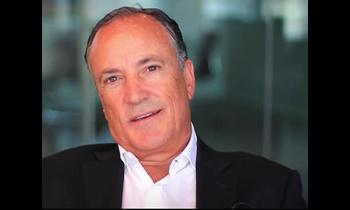
Today, when retailers install video cameras in their stores, they're leveraging them for far more than just loss prevention," Mack said "These cameras are used for marketing purposes, such as heat mapping to track where customers spend their time, managing inventory on shelves, monitoring employee activities, and ensuring safety compliance The range of applications continues to grow, delivering a significantly enhanced return on investment (ROI) that accelerates the adoption of these technologies because they provide so much more value."
This multifunctional utility also elevates the conversation to the CFO level. With multiple departments operations, marketing, HR, and others all advocating for an investment, the business case becomes far more compelling. When stakeholders align on the benefits, the likelihood of securing approval for the investment increases.
AI's integration into physical security systems is no longer futuristic Platforms now leverage AI for various use cases, such as facial recognition, license plate detection, and object identification Beyond security, these tools support business intelligence, compliance, and operational safety turning video surveillance systems into multi-functional assets
ata sovereignty and privacy considerations play a vital role in fostering trust and ensuring responsible adoption When taken into consideration, these factors can strengthen confidence in AI's potential By enhancing the deployment of advanced capabilities and optimizing service delivery, AI creates compelling value propositions that drive innovation and unlock new opportunities while maintaining a focus on ethical and responsible use.
Mobile credentials and identity management are playing a big part in reshaping access control Nearly 20% of credentials are now mobile According to Imperial Capital, nearly 89 million mobile credentials were downloaded globally in 2023, almost three times more than in 2021
Tech giants such as Apple, Google, and Samsung are propelling the adoption of mobile access badges by integrating them into digital wallets, a move gaining traction across higher education, multifamily, corporate, and SMB markets. While challenges like hardware upgrades and back-end integration remain, the transition toward democratized identity solutions highlights the ongoing convergence between physical and digital security ecosystems. This shift aligns with the growing demand for unified access platforms, paving the way for more seamless and integrated security solutions across the board.
Despite its reputation as a more slowly moving industry when compared to the tech hubs in Silicon Valley, the security industry is accelerating its adoption of transformative technologies The ROI narrative has shifted from risk mitigation to value creation, with solutions delivering multi-faceted benefits across departments This evolution, combined with strategic investments and a focus on innovation, is redefining the industry's future
Throughout 2025, Mack said we can expect to see the market experiencing continued momentum, with AI, RVM, and cloud solutions taking center stage. For businesses and investors, staying ahead will require embracing these trends and fostering cross-industry collaboration to unlock the full potential of the security ecosystem.


We offer AI-empowered solutions designed to safeguard your personnel and enhance security protocols across your premises, ensuring a secure and efficient work environment. Netwatch tailors its suite of services, including its staff safety solution, to meet your specific security challenges head-on Whether you operate retail spaces, bank branches, utilities, or car dealerships, we have the expertise and technology to make an impact and keep your team safe


The Security Industry Association’s 2025 Security Megatrends Report highlights the most critical developments shaping the security sector. Based on insights from industry executives and SIA advisory boards, this year ’ s report emphasizes the technological and business trends reshaping security.
The most significant trend of 2025 is the evolution of the security channel, which focuses on the changing role of integrators. With the rise of direct-to-consumer sales, cloud-based solutions, and AI-driven platforms, traditional security integrators must redefine their role Historically, these professionals were responsible for connecting disparate security systems, but as manufacturers develop more advanced, networked, and interoperable solutions, integrators must now offer business insights, software expertise, and managed services rather than just installing hardware
To stay relevant, they must invest in technical expertise to support AI systems, shift to managed services for RMR, specialize in key verticals, and aggregate insights across platforms to provide actionable intelligence.
Artificial intelligence remains one of the most important forces in the industry. AI is transitioning from pure hype to practical applications, particularly in predictive security and automation. Executives point to its impact in automating threat detection and response, reducing false alarms through contextual AI monitoring, enhancing security system diagnostics, and using predictive analytics for proactive risk mitigation While adoption is increasing, there are still concerns surrounding bias, ethics, and power consumption Additionally, many in the industry acknowledge a shortage of professionals with AI expertise, highlighting the need for greater training and education
Despite its fundamental importance, security continues to struggle with underfunding and being viewed primarily as a cost center rather than a business enabler Leaders have to stress the importance of demonstrating return on investment and aligning security with broader business objectives. Modern security platforms provide operational insights such as occupancy data and retail queue optimization, while also offering cost reduction opportunities through predictive maintenance and improved user experiences Positioning security as a business tool will also help leaders advocate for greater investment and strategic integration within organizations
Video surveillance is further evolving into visual intelligence Cameras are no longer recording devices but are increasingly being used as datadriven sensors AI-powered cameras can detect anomalies, analyze occupancy levels, and enhance operational efficiency. This is shifting the focus of video management systems, turning them into intelligent analytics platforms that provide insights beyond security.
The convergence of information technology, operational technology, and security is creating unified ecosystems
Several factors are driving this shift, including cyber-physical security threats requiring holistic responses, AI-driven analytics
bridging IT and OT insights, and cloud-based security solutions that merge IT and OT functions Security professionals now need to collaborate across departments to synchronize policies and infrastructure, ensuring a comprehensive approach to risk management.
With the proliferation of security technologies, applications, and data sources, many organizations are struggling with fragmented platforms. The leads to a demand for platform aggregation, which consolidates multiple systems into a single, unified platform This approach enhances situational awareness, streamlines data correlation, and improves efficiency in threat response Rather than managing disconnected components, organizations are increasingly seeking centralized solutions that analyze security data in real time

The industry is also witnessing a shift from physical key cards and badges to mobile credentials and biometric authentication. The widespread adoption of smartphone-based access control, the push toward digital identity verification, and biometrics are key drivers. Apple Wallet, Google Wallet, and other digital identity frameworks are entering the space, prompting security leaders to integrate mobile identity into their access control strategies
Advancements in detection technologies are also addressing a broader range of threats beyond traditional motion sensors and alarms New developments to watch include AI-powered weapons detection

gunshot detection with real-time location mapping, LiDAR and radar-based perimeter security, and environmental sensors for air quality and chemical detection These technologies enable real-time threat identification and proactive security measures.
Security has historically been hardware-centric, with a focus on cameras, alarms, and access control devices. But today, software is now becoming the primary focus of security solutions. Cloud-based security management platforms are gaining dominance, edge computing is making devices smarter, and AI-driven software is extracting more insights from security data. This shift reflects a growing emphasis on data-driven decision-making.
A significant transformation is occurring in the way security solutions are deployed and maintained. The adoption of as-a-service models is reshaping business strategies. Instead of relying on one-time hardware sales, security companies are moving toward subscription-based models that bundle hardware, software, and services together This approach provides customers with continuous updates, support, and scalable security solutions
Today, we see a clear picture of an industry undergoing fundamental changes Security professionals must adapt to these changes by leveraging AI and analytics to enhance efficiency, transitioning from hardware-based solutions to software-driven platforms, integrating security with IT and OT for a more comprehensive risk management approach, and embracing managed services models for sustained growth As technology advances, security professionals will increasingly be seen as protectors of assets as well as strategic enablers of business intelligence and operational success
TECHNOLOGY. PEOPLE. INTELLIGENCE.


Read more online at netwatchglobal.ai/horizon